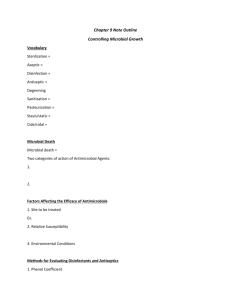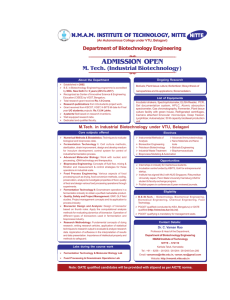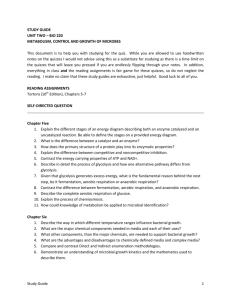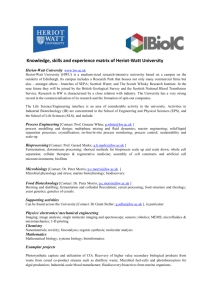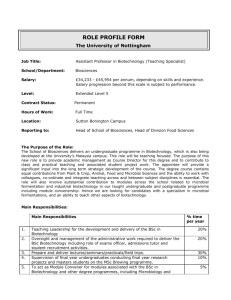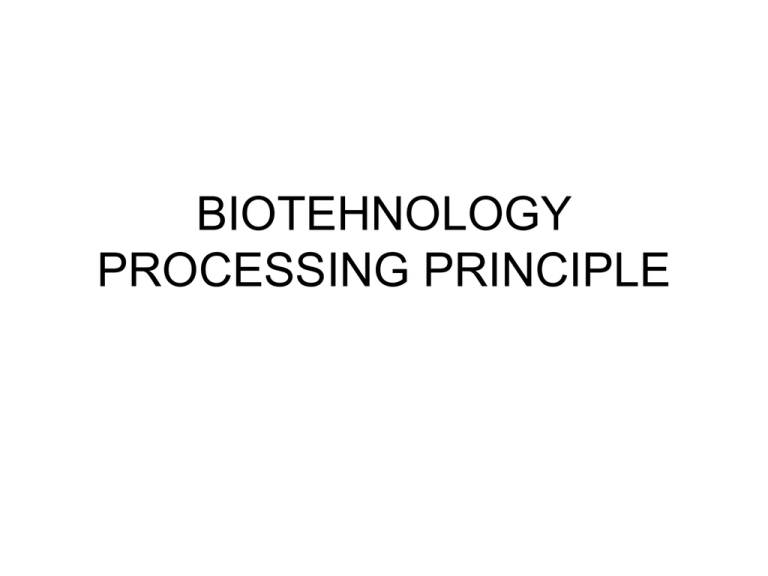
BIOTEHNOLOGY
PROCESSING PRINCIPLE
What is biotechnology?
• The Office of Technology Assessment of
the US Congress defined as:
“Any techniques that uses living organisms
or substances from those organisms, to
make or modify a product, to improve
plants or animals, or to develop
microorganisms for specific uses.”
Why Biotechnology Such A Big
Deal?
•
1.
2.
3.
4.
5.
6.
The benefits of biotechnology may be
discussed under 6 major categories:
Agriculture (crop, livestock).
Industry (ethanol, biofuel, bioplastic).
Health/medicine (diagnostic tool, vaccine)
Environmental (bioremediation, disease
resistant cultivar)
Forensic (crime, paternity disputes)
Advancement of knowledge
What is a bioprocess?
• An industrial operation in which living
systems are used to transform raw
materials (biological or nonbiological) into
products.
• It is a multidiscipline (biochemistry +
chemical engineering + biotechnology)
area.
• Process to use biology system in
commercial scales.
Biotechnology can be bring into
bioprocess because:
1.The present of engineering innovation:
- exp. genetic engineering, discovery of sitespecific enzyme cleavage of DNA by restriction
endonucleases in bacteria is the key to DNA
manipulation.
2. The development of appropriate enabling
technologies:
- Polymerase chain reaction (PCR) technology
- Blotting technology
- Fermenter technology
3.Economic opportunity
- Arise from identifiable potential benefit
that may accrue to society from
development of a product.
KEY STEPS IN BIOPROSES ENGINEERING
1. Pretreatment
2. Bioreaction
3. Downstream processing
pretreatment
Suit raw material
into process
equipment
Design of process
Equipment
According to
Physical & chemical
properties
Environment factorsphysiologically
tolerance of
the organism
and enzymes.
Bioreaction
1. Bioreactor fluids
2. Media sterilization
3. Growth media
4. Microbial growth
5. Mirobial culture systems in bioreactors
6. Bioreactors
1.
i.
ii.
Bioreactor Fluids
Medium in which a bioprocess occurs is
usually a liquid or slurry.
two main kinds of biofluids and slurries used.
Newtonian fluids
Non-Newtonian fluids
2. Media Sterilization
To initiate specific microorganisms for a
specific purpose.
Usually filter sterilization or heat sterilization.
Heat sterilization may be accomplished in
batch sterilization or continuous sterilization.
3. Growth Media
- Formulated to maintain microbial growth
for economic production of the target
products.
- Should consists basic components such
as carbon source, nitrogen source,
minerals, vitamins, micronutrients,
hormones and oxygen.
- May contain additives that facilitate the
process e.g antifoams.
4. Microbial Growth
Progresses through four basic phases (lag,
exponential, stationary and death).
Usually 5 to 10 percent by volume of microbial
suspension in a rapid exponential growth phase may
be used.
5. Microbial Culture System in Bioreactors
Grown in three basic ways:
1. Batch fermentation
2. Fed-batch fermentation
3. Continuous fermentation.
6. Bioreactors (will be discussed further)
Designs
Mode of operation
Downstream Processing
- To retrieve, purify and pack products for use of
sales.
- Involves a number of processing.
1. Solid-liquid separation
- To separate cells (solid) from the liquid.
- Commonly used: centrifugation and filtration.
2. Cell disruption
- Extracellular product: the cells are discarded
and the medium is concentrated and purified.
- Intracellular product: cells have to be disrupted
using nonmechanical or mechanical method.
i.
-
Nonmechanical methods
Using various chemicals, including alkali,
organic solvents, and detergents.
- Also some enzymes such as lysozyme, EDTA,
β-1,3-glucanase, mannase and chitinase.
- Other physical methods are osmotic shock and
pressure.
ii. Mechanical methods
- Two catagories: solid shear and liquid shear.
- Solid shear: grinding of frozen cells through
narrow gaps under high pressure.
- Liquid shear: acceleration of the suspension at
a high velocity and under high pressure.
3. Precipitation
- To convert the soluble protein product to
insoluble form.
- Commonly used is salting-out technique
using anions and cations.
4. Chromatography
- To separate components of mixtures
based on their differential physiochemical
interaction and a stationary phase.
- The stationary phase is a solid packed in a
column by porous and hydrophilic
substances like agarose, cross-linked
polyacrylamide, and cellulose.
5. Drying
- Required for safe-storage, packaging, and
transportation.
- Dehydration is used for vaccines,
enzymes, pharmaceuticals and others.
- For thermolabile products or biologically
active, spray-dried or freeze-dried.
References:
1. Acquaah, G. (2004). Understanding
Biotechnology:An Integrated and CyberBased Approach. Pearson-Prentice Hall.
B. Mode of cells growth
i. Immobilized cell system
ii. Suspension cultures
Immobilized cell system
Advantages:
1.Provides high cell concentrations
2.Provides cell reuse
3. Eliminates cell washout problems at high
dilution rates
4. Allows high volumetric productivities.
5. Provide favorable microenvironmental
conditions for cells, resulting in better
performance of biocatalytics.
6. In some cases, improves genetic stability
7. Protection against shear damage.
Limitation:
1.The interest product should b excreted by
the cells.
2.

